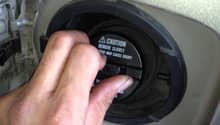C6 Corvette: How to Fix a Tire Leak
Follow these do-it-yourself instructions to fix a tire leak on your C6 Corvette.
This article applies to the C6 Corvette (2005-2013).
Fixing a tire leak on your C6 Corvette is a fairly simple task that only requires patience and the correct tools. It is important to note at the outset that whenever possible, you should avoid all temporary inflation foaming products that can be inserted into your tire. These temporary filling products will not only make your tire difficult to repair in the future, but in some cases your tire may be completely refused by tire repair shops. Additionally, foaming products can also affect the Corvette's TPMS system by causing corrosion and damage.

Materials Needed
- Jack stands
- Lug wrench/tool
- Soap and water in spray bottle
- Pliers
- Plug kit including T-handle probe, T-handle insertion tool, cement and plug
Step 1 – Loosen the lug nuts, jack the car up and remove the tire
Follow the instructions in your owner's manual, and loosen the lug nuts on your tire. Then, safely jack your Corvette up and remove the tire for further inspection.
Pro Tip
If you can visually determine that the leak is not on the tread but rather on the side wall of the tire, do not remove the tire, as you will not be able to plug that type of damage. At that point, either use the temporary fixing foam or fill the tire, and proceed to the tire store as quickly as possible.

(Related Article: How to Jack Up Your Vette - CorvetteForum.com)
Step 2 – Visually locate where the tire is leaking from
In most cases, you will be able to visually locate where the leak is coming from, based on seeing the object that has punctured the tire. There may be a nail, or you may able to hear a hissing noise. Remove the item from the tire with a pair of pliers. If you are unable to locate the leak visually, prepare a spray bottle of soapy water and spray the tire section by section, looking for bubbles coming from the punctured area.
If the previous two methods do not show the leak area, then submerge the entire wheel into a large bucket or small pool of water, and look for the bubbles releasing from the affected area. Use a colored marker or or crayon to circle the area once you have discovered it.

Step 3 – Use the T-handle probe to clean the puncture
Insert the T-handle probe into the affected area and, while using a quick motion, push the T-handle in and out of the tire. This will not only clean out any extra debris, but will also prepare the area for the plug.

Step 4 – Insert plug
By following the plug kit instructions, place the appropriate amount of cement or sealant on the plug, and use the T-handle insertion tool to place the plug into the damaged area. Leave approximately 1 inch of the plug protruding from the exterior of the tire.

Step 5 – Remove excess material
Let the plug dry for approximately 5 minutes, then cut away the excess material.

Step 6 – Re-inflate the tire
Re-inflate to the appropriate air pressure, and spray the soapy water mixture on the affected area to check for any additional leakage.

Figure 6. Inserting re-inflation tool. 
Figure 7. Water mixture on patched hole.
Step 7 – Re-install the wheel
Re-install the wheel and tighten the lug nuts. Lower your Corvette and give it a test drive to make sure everything is secured.

Related Discussions and Site
- C5 Non-Runflat Tire Discussion - CorvetteForum.com
- Runflat Versus Non-Runflat - CorvetteForum.com
- Fix-a-Flat - WikiHow.com






